Evaluating BIM's Role in Sustainable Construction and Renovation
VerifiedAdded on 2020/10/22
|10
|2418
|338
Report
AI Summary
This report delves into the application of Building Information Modeling (BIM) in sustainable construction and renovation projects, focusing on the use of both quantitative and qualitative research methods. It examines how BIM enhances building design, improves efficiency, and contributes to environmental protection. The report analyzes the benefits of BIM, including its role in cost estimation, material management, and adherence to sustainability regulations. It also explores various research methodologies, such as case studies and data analysis, to assess BIM's impact on renovation processes. The report highlights the importance of selecting appropriate research methods for gathering accurate data and drawing relevant conclusions about the effectiveness of BIM in promoting sustainable construction practices. It evaluates how government regulations and industry practices influence BIM implementation and its potential for future advancements in the construction sector. Furthermore, the report discusses the advantages and disadvantages of each research method, providing a comprehensive understanding of BIM's role in shaping the future of sustainable building renovation.

RM
Paraphrase This Document
Need a fresh take? Get an instant paraphrase of this document with our AI Paraphraser
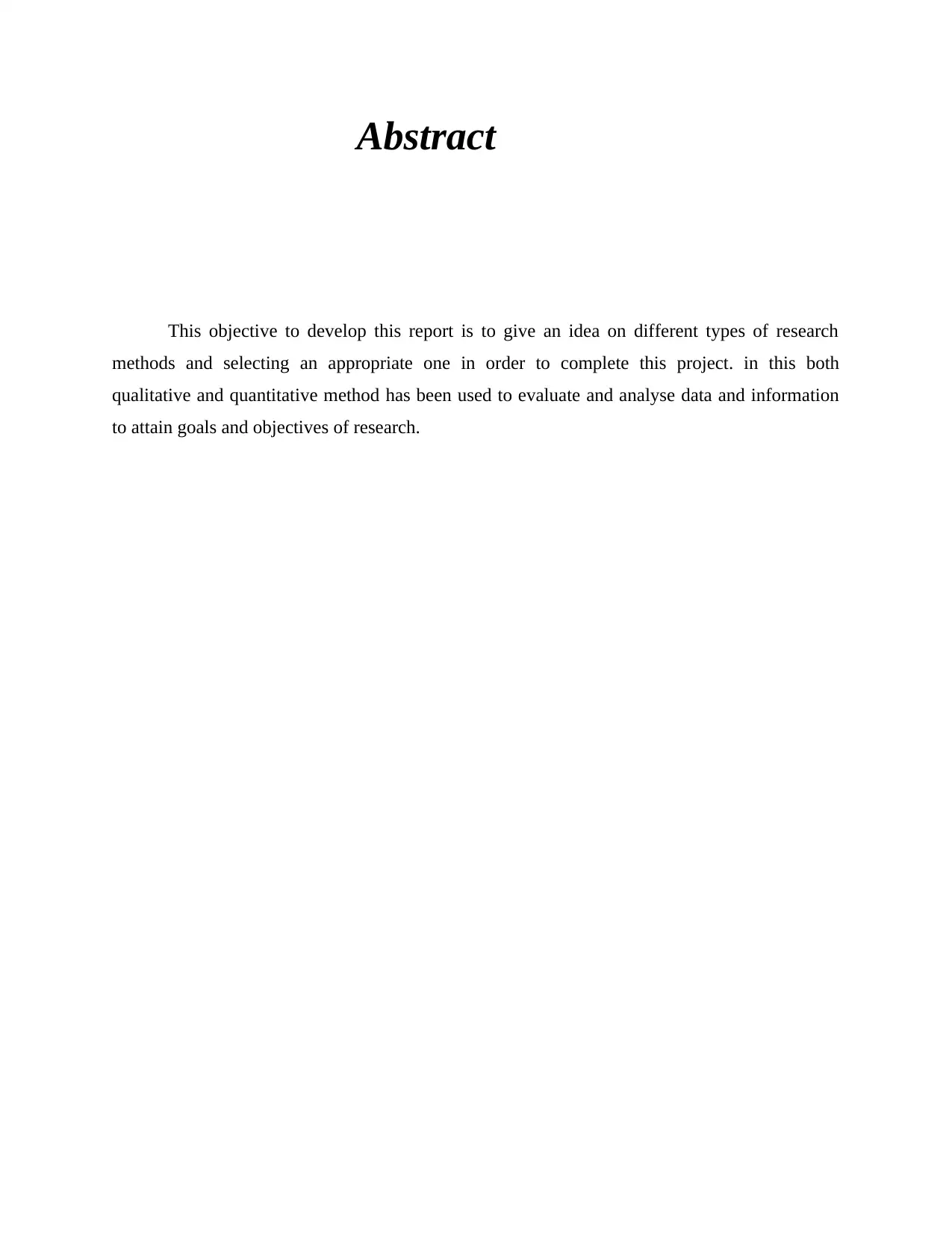
Abstract
This objective to develop this report is to give an idea on different types of research
methods and selecting an appropriate one in order to complete this project. in this both
qualitative and quantitative method has been used to evaluate and analyse data and information
to attain goals and objectives of research.
This objective to develop this report is to give an idea on different types of research
methods and selecting an appropriate one in order to complete this project. in this both
qualitative and quantitative method has been used to evaluate and analyse data and information
to attain goals and objectives of research.
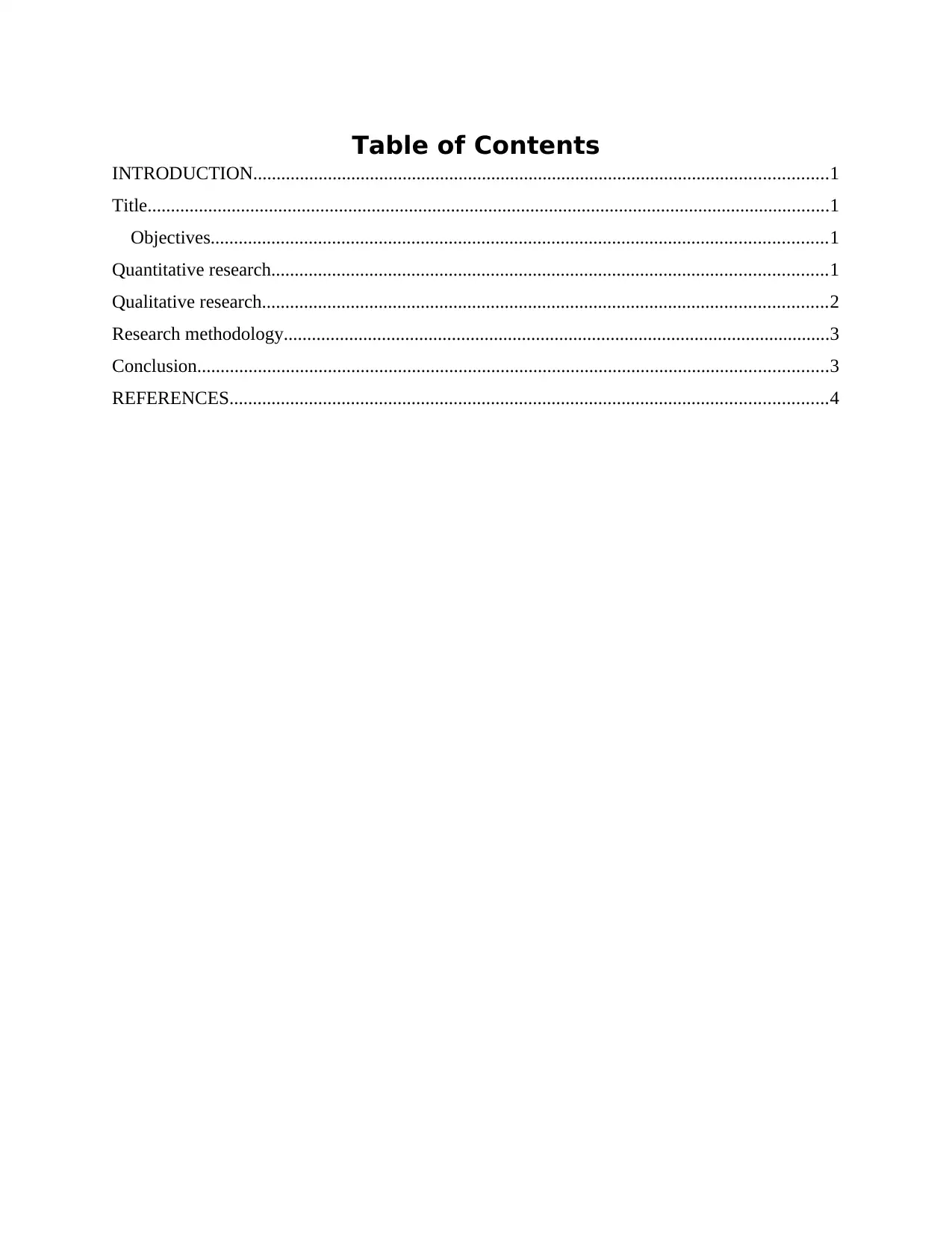
Table of Contents
INTRODUCTION...........................................................................................................................1
Title..................................................................................................................................................1
Objectives....................................................................................................................................1
Quantitative research.......................................................................................................................1
Qualitative research.........................................................................................................................2
Research methodology.....................................................................................................................3
Conclusion.......................................................................................................................................3
REFERENCES................................................................................................................................4
INTRODUCTION...........................................................................................................................1
Title..................................................................................................................................................1
Objectives....................................................................................................................................1
Quantitative research.......................................................................................................................1
Qualitative research.........................................................................................................................2
Research methodology.....................................................................................................................3
Conclusion.......................................................................................................................................3
REFERENCES................................................................................................................................4
⊘ This is a preview!⊘
Do you want full access?
Subscribe today to unlock all pages.

Trusted by 1+ million students worldwide
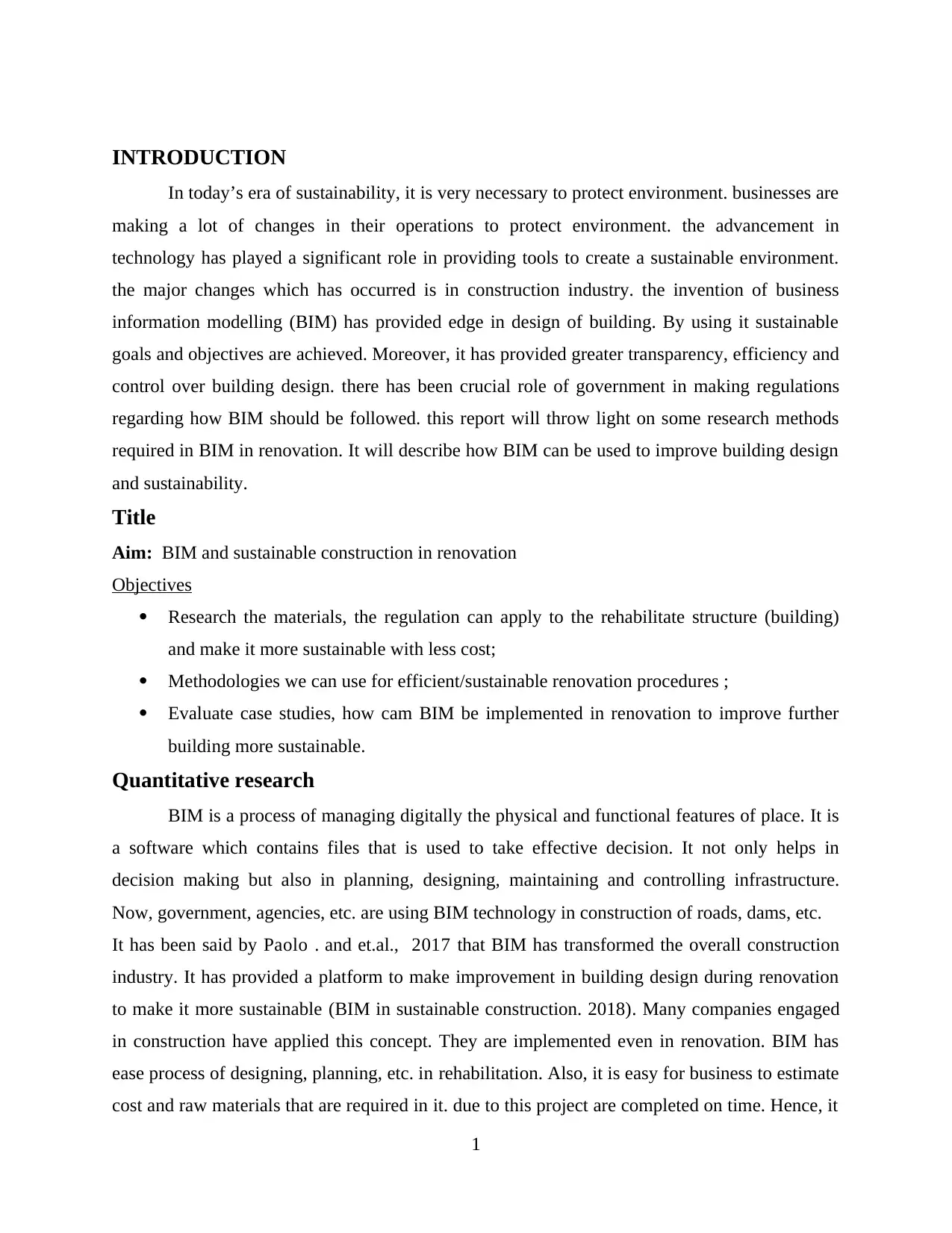
INTRODUCTION
In today’s era of sustainability, it is very necessary to protect environment. businesses are
making a lot of changes in their operations to protect environment. the advancement in
technology has played a significant role in providing tools to create a sustainable environment.
the major changes which has occurred is in construction industry. the invention of business
information modelling (BIM) has provided edge in design of building. By using it sustainable
goals and objectives are achieved. Moreover, it has provided greater transparency, efficiency and
control over building design. there has been crucial role of government in making regulations
regarding how BIM should be followed. this report will throw light on some research methods
required in BIM in renovation. It will describe how BIM can be used to improve building design
and sustainability.
Title
Aim: BIM and sustainable construction in renovation
Objectives
Research the materials, the regulation can apply to the rehabilitate structure (building)
and make it more sustainable with less cost;
Methodologies we can use for efficient/sustainable renovation procedures ;
Evaluate case studies, how cam BIM be implemented in renovation to improve further
building more sustainable.
Quantitative research
BIM is a process of managing digitally the physical and functional features of place. It is
a software which contains files that is used to take effective decision. It not only helps in
decision making but also in planning, designing, maintaining and controlling infrastructure.
Now, government, agencies, etc. are using BIM technology in construction of roads, dams, etc.
It has been said by Paolo . and et.al., 2017 that BIM has transformed the overall construction
industry. It has provided a platform to make improvement in building design during renovation
to make it more sustainable (BIM in sustainable construction. 2018). Many companies engaged
in construction have applied this concept. They are implemented even in renovation. BIM has
ease process of designing, planning, etc. in rehabilitation. Also, it is easy for business to estimate
cost and raw materials that are required in it. due to this project are completed on time. Hence, it
1
In today’s era of sustainability, it is very necessary to protect environment. businesses are
making a lot of changes in their operations to protect environment. the advancement in
technology has played a significant role in providing tools to create a sustainable environment.
the major changes which has occurred is in construction industry. the invention of business
information modelling (BIM) has provided edge in design of building. By using it sustainable
goals and objectives are achieved. Moreover, it has provided greater transparency, efficiency and
control over building design. there has been crucial role of government in making regulations
regarding how BIM should be followed. this report will throw light on some research methods
required in BIM in renovation. It will describe how BIM can be used to improve building design
and sustainability.
Title
Aim: BIM and sustainable construction in renovation
Objectives
Research the materials, the regulation can apply to the rehabilitate structure (building)
and make it more sustainable with less cost;
Methodologies we can use for efficient/sustainable renovation procedures ;
Evaluate case studies, how cam BIM be implemented in renovation to improve further
building more sustainable.
Quantitative research
BIM is a process of managing digitally the physical and functional features of place. It is
a software which contains files that is used to take effective decision. It not only helps in
decision making but also in planning, designing, maintaining and controlling infrastructure.
Now, government, agencies, etc. are using BIM technology in construction of roads, dams, etc.
It has been said by Paolo . and et.al., 2017 that BIM has transformed the overall construction
industry. It has provided a platform to make improvement in building design during renovation
to make it more sustainable (BIM in sustainable construction. 2018). Many companies engaged
in construction have applied this concept. They are implemented even in renovation. BIM has
ease process of designing, planning, etc. in rehabilitation. Also, it is easy for business to estimate
cost and raw materials that are required in it. due to this project are completed on time. Hence, it
1
Paraphrase This Document
Need a fresh take? Get an instant paraphrase of this document with our AI Paraphraser
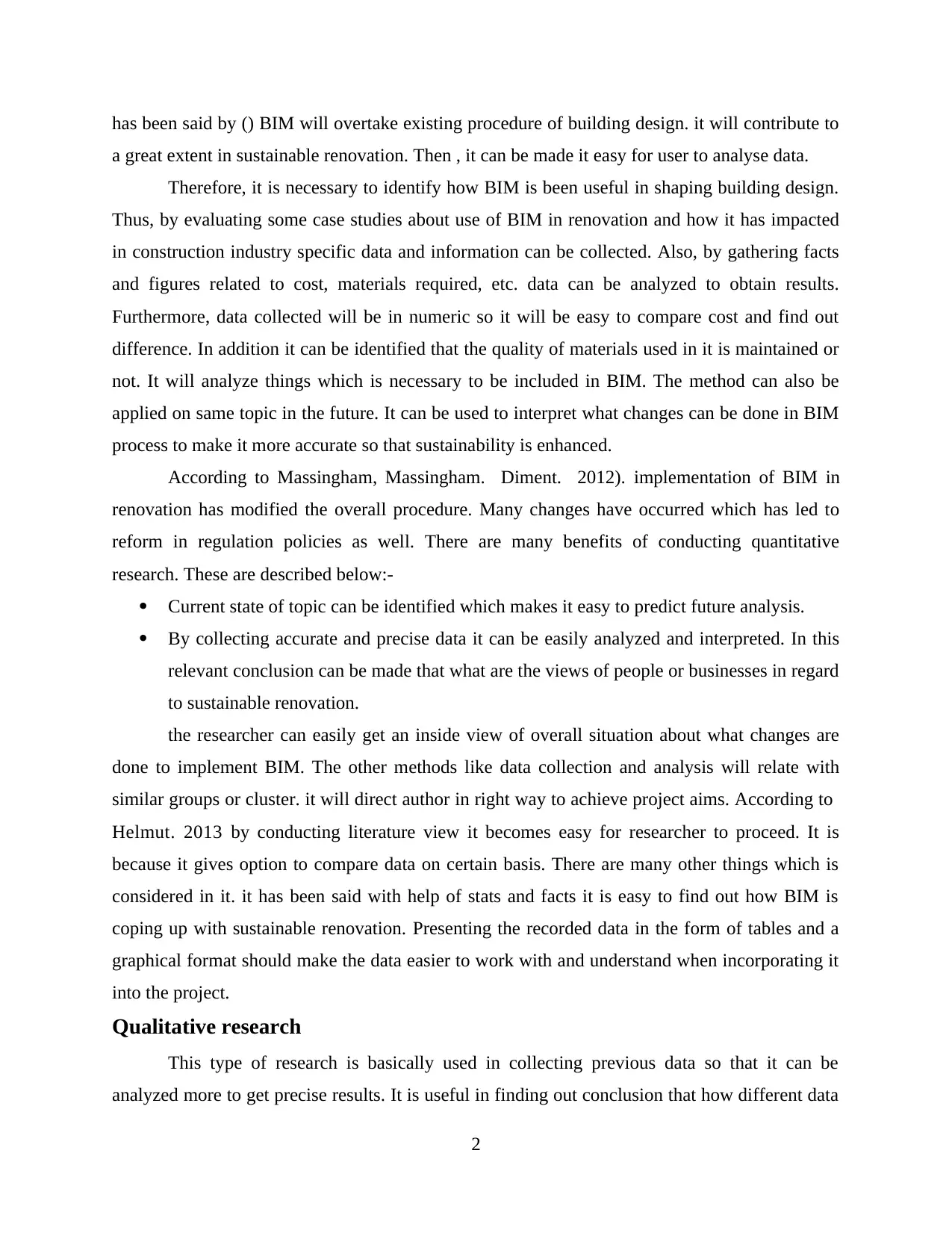
has been said by () BIM will overtake existing procedure of building design. it will contribute to
a great extent in sustainable renovation. Then , it can be made it easy for user to analyse data.
Therefore, it is necessary to identify how BIM is been useful in shaping building design.
Thus, by evaluating some case studies about use of BIM in renovation and how it has impacted
in construction industry specific data and information can be collected. Also, by gathering facts
and figures related to cost, materials required, etc. data can be analyzed to obtain results.
Furthermore, data collected will be in numeric so it will be easy to compare cost and find out
difference. In addition it can be identified that the quality of materials used in it is maintained or
not. It will analyze things which is necessary to be included in BIM. The method can also be
applied on same topic in the future. It can be used to interpret what changes can be done in BIM
process to make it more accurate so that sustainability is enhanced.
According to Massingham, Massingham. Diment. 2012). implementation of BIM in
renovation has modified the overall procedure. Many changes have occurred which has led to
reform in regulation policies as well. There are many benefits of conducting quantitative
research. These are described below:-
Current state of topic can be identified which makes it easy to predict future analysis.
By collecting accurate and precise data it can be easily analyzed and interpreted. In this
relevant conclusion can be made that what are the views of people or businesses in regard
to sustainable renovation.
the researcher can easily get an inside view of overall situation about what changes are
done to implement BIM. The other methods like data collection and analysis will relate with
similar groups or cluster. it will direct author in right way to achieve project aims. According to
Helmut. 2013 by conducting literature view it becomes easy for researcher to proceed. It is
because it gives option to compare data on certain basis. There are many other things which is
considered in it. it has been said with help of stats and facts it is easy to find out how BIM is
coping up with sustainable renovation. Presenting the recorded data in the form of tables and a
graphical format should make the data easier to work with and understand when incorporating it
into the project.
Qualitative research
This type of research is basically used in collecting previous data so that it can be
analyzed more to get precise results. It is useful in finding out conclusion that how different data
2
a great extent in sustainable renovation. Then , it can be made it easy for user to analyse data.
Therefore, it is necessary to identify how BIM is been useful in shaping building design.
Thus, by evaluating some case studies about use of BIM in renovation and how it has impacted
in construction industry specific data and information can be collected. Also, by gathering facts
and figures related to cost, materials required, etc. data can be analyzed to obtain results.
Furthermore, data collected will be in numeric so it will be easy to compare cost and find out
difference. In addition it can be identified that the quality of materials used in it is maintained or
not. It will analyze things which is necessary to be included in BIM. The method can also be
applied on same topic in the future. It can be used to interpret what changes can be done in BIM
process to make it more accurate so that sustainability is enhanced.
According to Massingham, Massingham. Diment. 2012). implementation of BIM in
renovation has modified the overall procedure. Many changes have occurred which has led to
reform in regulation policies as well. There are many benefits of conducting quantitative
research. These are described below:-
Current state of topic can be identified which makes it easy to predict future analysis.
By collecting accurate and precise data it can be easily analyzed and interpreted. In this
relevant conclusion can be made that what are the views of people or businesses in regard
to sustainable renovation.
the researcher can easily get an inside view of overall situation about what changes are
done to implement BIM. The other methods like data collection and analysis will relate with
similar groups or cluster. it will direct author in right way to achieve project aims. According to
Helmut. 2013 by conducting literature view it becomes easy for researcher to proceed. It is
because it gives option to compare data on certain basis. There are many other things which is
considered in it. it has been said with help of stats and facts it is easy to find out how BIM is
coping up with sustainable renovation. Presenting the recorded data in the form of tables and a
graphical format should make the data easier to work with and understand when incorporating it
into the project.
Qualitative research
This type of research is basically used in collecting previous data so that it can be
analyzed more to get precise results. It is useful in finding out conclusion that how different data
2
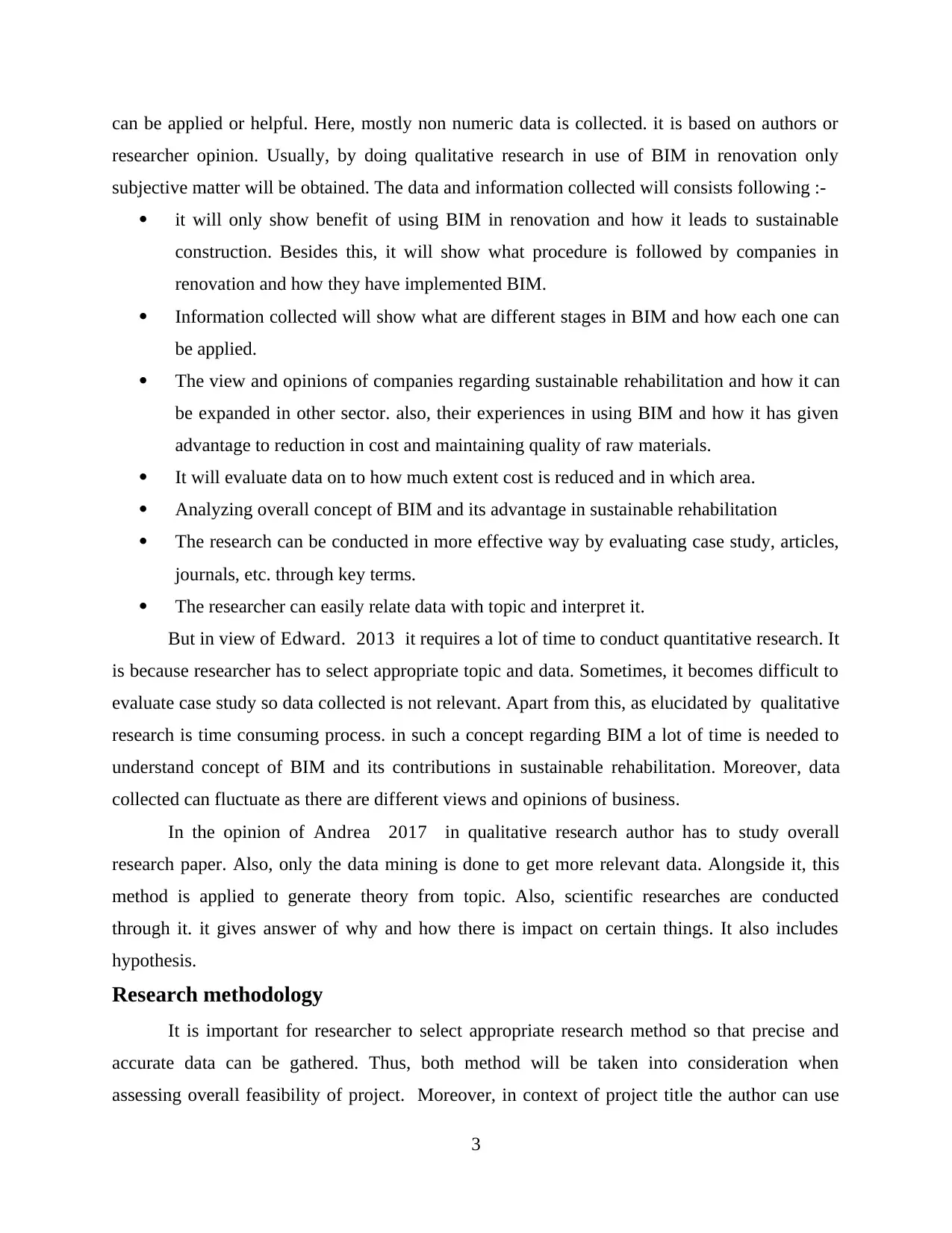
can be applied or helpful. Here, mostly non numeric data is collected. it is based on authors or
researcher opinion. Usually, by doing qualitative research in use of BIM in renovation only
subjective matter will be obtained. The data and information collected will consists following :-
it will only show benefit of using BIM in renovation and how it leads to sustainable
construction. Besides this, it will show what procedure is followed by companies in
renovation and how they have implemented BIM.
Information collected will show what are different stages in BIM and how each one can
be applied.
The view and opinions of companies regarding sustainable rehabilitation and how it can
be expanded in other sector. also, their experiences in using BIM and how it has given
advantage to reduction in cost and maintaining quality of raw materials.
It will evaluate data on to how much extent cost is reduced and in which area.
Analyzing overall concept of BIM and its advantage in sustainable rehabilitation
The research can be conducted in more effective way by evaluating case study, articles,
journals, etc. through key terms.
The researcher can easily relate data with topic and interpret it.
But in view of Edward. 2013 it requires a lot of time to conduct quantitative research. It
is because researcher has to select appropriate topic and data. Sometimes, it becomes difficult to
evaluate case study so data collected is not relevant. Apart from this, as elucidated by qualitative
research is time consuming process. in such a concept regarding BIM a lot of time is needed to
understand concept of BIM and its contributions in sustainable rehabilitation. Moreover, data
collected can fluctuate as there are different views and opinions of business.
In the opinion of Andrea 2017 in qualitative research author has to study overall
research paper. Also, only the data mining is done to get more relevant data. Alongside it, this
method is applied to generate theory from topic. Also, scientific researches are conducted
through it. it gives answer of why and how there is impact on certain things. It also includes
hypothesis.
Research methodology
It is important for researcher to select appropriate research method so that precise and
accurate data can be gathered. Thus, both method will be taken into consideration when
assessing overall feasibility of project. Moreover, in context of project title the author can use
3
researcher opinion. Usually, by doing qualitative research in use of BIM in renovation only
subjective matter will be obtained. The data and information collected will consists following :-
it will only show benefit of using BIM in renovation and how it leads to sustainable
construction. Besides this, it will show what procedure is followed by companies in
renovation and how they have implemented BIM.
Information collected will show what are different stages in BIM and how each one can
be applied.
The view and opinions of companies regarding sustainable rehabilitation and how it can
be expanded in other sector. also, their experiences in using BIM and how it has given
advantage to reduction in cost and maintaining quality of raw materials.
It will evaluate data on to how much extent cost is reduced and in which area.
Analyzing overall concept of BIM and its advantage in sustainable rehabilitation
The research can be conducted in more effective way by evaluating case study, articles,
journals, etc. through key terms.
The researcher can easily relate data with topic and interpret it.
But in view of Edward. 2013 it requires a lot of time to conduct quantitative research. It
is because researcher has to select appropriate topic and data. Sometimes, it becomes difficult to
evaluate case study so data collected is not relevant. Apart from this, as elucidated by qualitative
research is time consuming process. in such a concept regarding BIM a lot of time is needed to
understand concept of BIM and its contributions in sustainable rehabilitation. Moreover, data
collected can fluctuate as there are different views and opinions of business.
In the opinion of Andrea 2017 in qualitative research author has to study overall
research paper. Also, only the data mining is done to get more relevant data. Alongside it, this
method is applied to generate theory from topic. Also, scientific researches are conducted
through it. it gives answer of why and how there is impact on certain things. It also includes
hypothesis.
Research methodology
It is important for researcher to select appropriate research method so that precise and
accurate data can be gathered. Thus, both method will be taken into consideration when
assessing overall feasibility of project. Moreover, in context of project title the author can use
3
⊘ This is a preview!⊘
Do you want full access?
Subscribe today to unlock all pages.

Trusted by 1+ million students worldwide
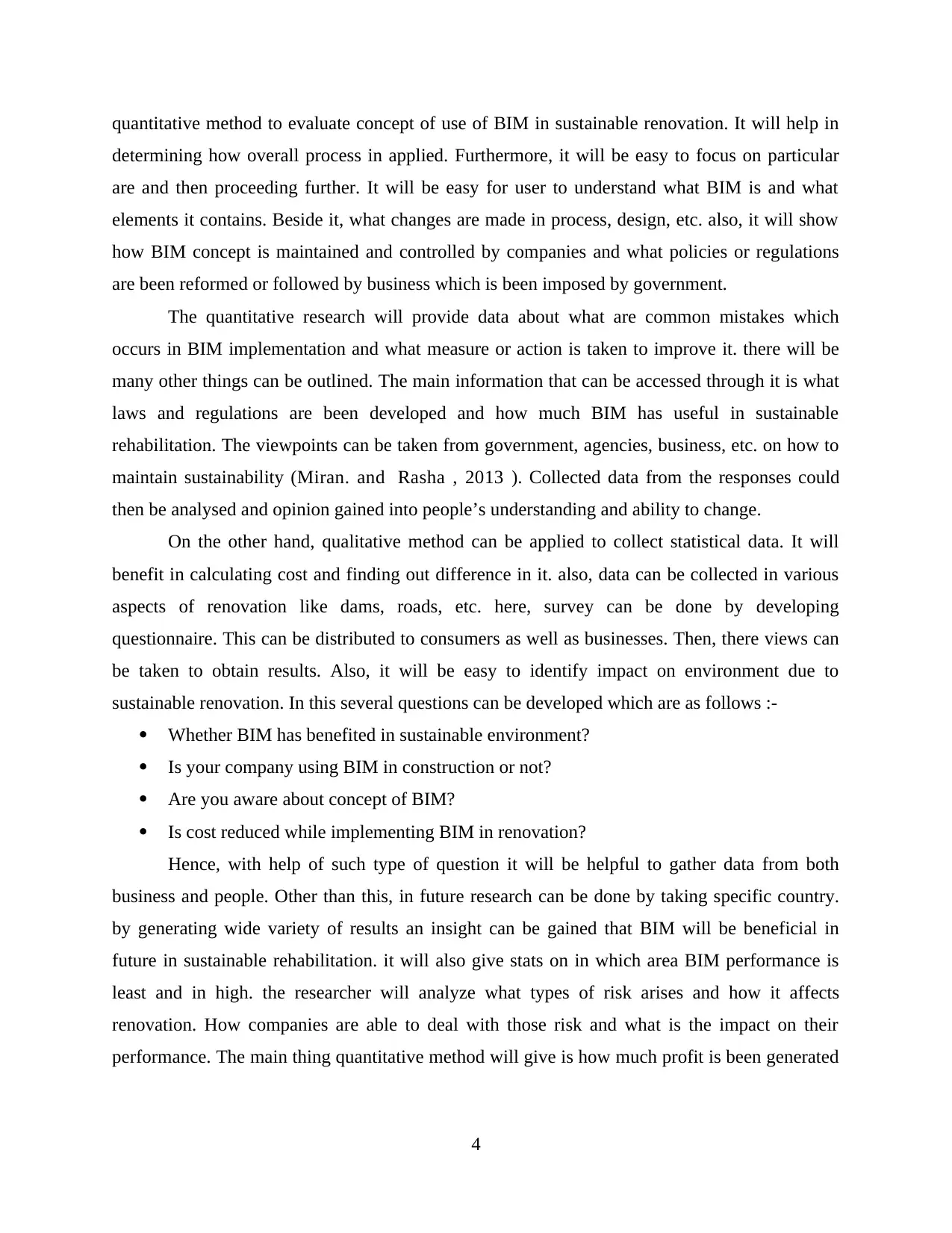
quantitative method to evaluate concept of use of BIM in sustainable renovation. It will help in
determining how overall process in applied. Furthermore, it will be easy to focus on particular
are and then proceeding further. It will be easy for user to understand what BIM is and what
elements it contains. Beside it, what changes are made in process, design, etc. also, it will show
how BIM concept is maintained and controlled by companies and what policies or regulations
are been reformed or followed by business which is been imposed by government.
The quantitative research will provide data about what are common mistakes which
occurs in BIM implementation and what measure or action is taken to improve it. there will be
many other things can be outlined. The main information that can be accessed through it is what
laws and regulations are been developed and how much BIM has useful in sustainable
rehabilitation. The viewpoints can be taken from government, agencies, business, etc. on how to
maintain sustainability (Miran. and Rasha , 2013 ). Collected data from the responses could
then be analysed and opinion gained into people’s understanding and ability to change.
On the other hand, qualitative method can be applied to collect statistical data. It will
benefit in calculating cost and finding out difference in it. also, data can be collected in various
aspects of renovation like dams, roads, etc. here, survey can be done by developing
questionnaire. This can be distributed to consumers as well as businesses. Then, there views can
be taken to obtain results. Also, it will be easy to identify impact on environment due to
sustainable renovation. In this several questions can be developed which are as follows :-
Whether BIM has benefited in sustainable environment?
Is your company using BIM in construction or not?
Are you aware about concept of BIM?
Is cost reduced while implementing BIM in renovation?
Hence, with help of such type of question it will be helpful to gather data from both
business and people. Other than this, in future research can be done by taking specific country.
by generating wide variety of results an insight can be gained that BIM will be beneficial in
future in sustainable rehabilitation. it will also give stats on in which area BIM performance is
least and in high. the researcher will analyze what types of risk arises and how it affects
renovation. How companies are able to deal with those risk and what is the impact on their
performance. The main thing quantitative method will give is how much profit is been generated
4
determining how overall process in applied. Furthermore, it will be easy to focus on particular
are and then proceeding further. It will be easy for user to understand what BIM is and what
elements it contains. Beside it, what changes are made in process, design, etc. also, it will show
how BIM concept is maintained and controlled by companies and what policies or regulations
are been reformed or followed by business which is been imposed by government.
The quantitative research will provide data about what are common mistakes which
occurs in BIM implementation and what measure or action is taken to improve it. there will be
many other things can be outlined. The main information that can be accessed through it is what
laws and regulations are been developed and how much BIM has useful in sustainable
rehabilitation. The viewpoints can be taken from government, agencies, business, etc. on how to
maintain sustainability (Miran. and Rasha , 2013 ). Collected data from the responses could
then be analysed and opinion gained into people’s understanding and ability to change.
On the other hand, qualitative method can be applied to collect statistical data. It will
benefit in calculating cost and finding out difference in it. also, data can be collected in various
aspects of renovation like dams, roads, etc. here, survey can be done by developing
questionnaire. This can be distributed to consumers as well as businesses. Then, there views can
be taken to obtain results. Also, it will be easy to identify impact on environment due to
sustainable renovation. In this several questions can be developed which are as follows :-
Whether BIM has benefited in sustainable environment?
Is your company using BIM in construction or not?
Are you aware about concept of BIM?
Is cost reduced while implementing BIM in renovation?
Hence, with help of such type of question it will be helpful to gather data from both
business and people. Other than this, in future research can be done by taking specific country.
by generating wide variety of results an insight can be gained that BIM will be beneficial in
future in sustainable rehabilitation. it will also give stats on in which area BIM performance is
least and in high. the researcher will analyze what types of risk arises and how it affects
renovation. How companies are able to deal with those risk and what is the impact on their
performance. The main thing quantitative method will give is how much profit is been generated
4
Paraphrase This Document
Need a fresh take? Get an instant paraphrase of this document with our AI Paraphraser
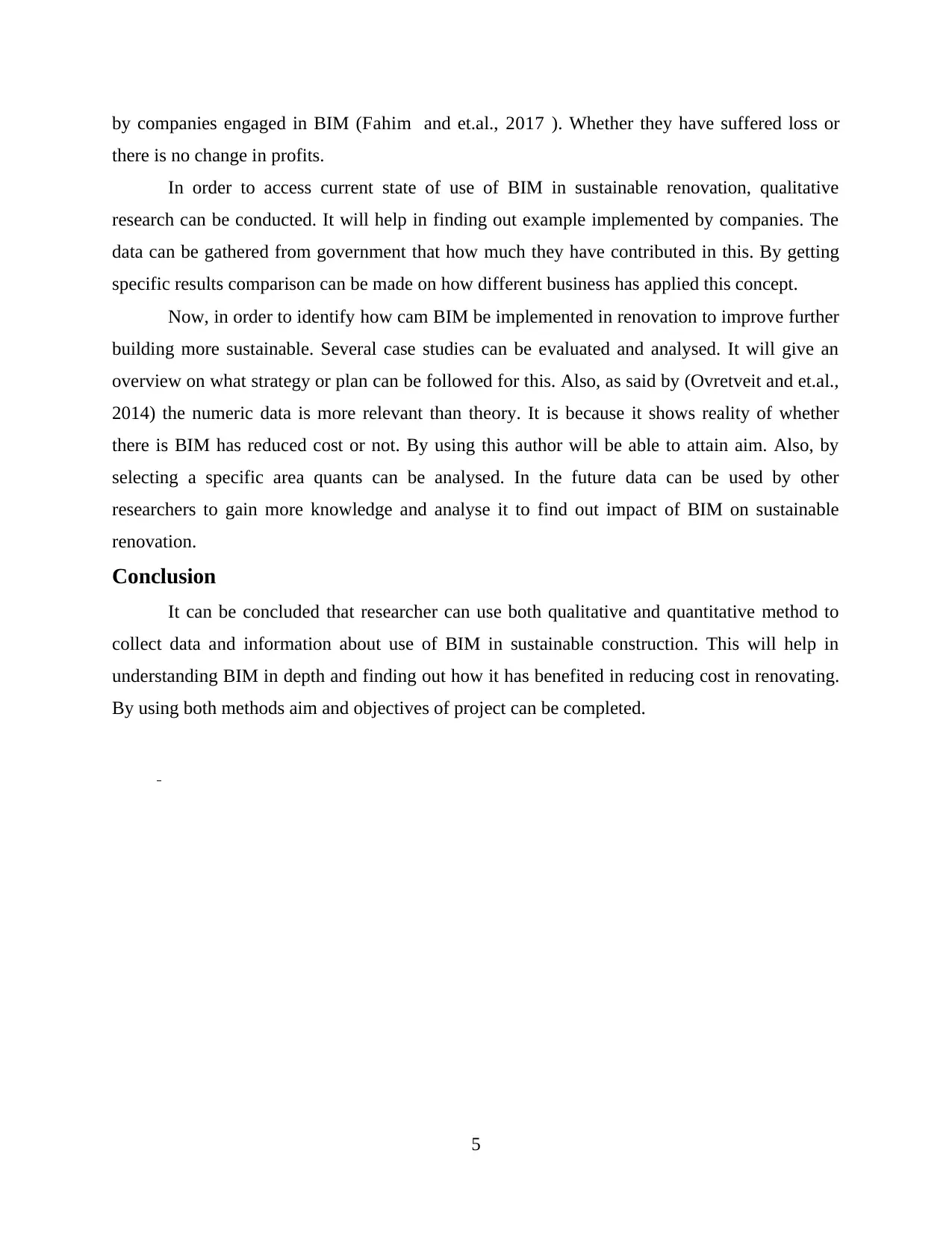
by companies engaged in BIM (Fahim and et.al., 2017 ). Whether they have suffered loss or
there is no change in profits.
In order to access current state of use of BIM in sustainable renovation, qualitative
research can be conducted. It will help in finding out example implemented by companies. The
data can be gathered from government that how much they have contributed in this. By getting
specific results comparison can be made on how different business has applied this concept.
Now, in order to identify how cam BIM be implemented in renovation to improve further
building more sustainable. Several case studies can be evaluated and analysed. It will give an
overview on what strategy or plan can be followed for this. Also, as said by (Ovretveit and et.al.,
2014) the numeric data is more relevant than theory. It is because it shows reality of whether
there is BIM has reduced cost or not. By using this author will be able to attain aim. Also, by
selecting a specific area quants can be analysed. In the future data can be used by other
researchers to gain more knowledge and analyse it to find out impact of BIM on sustainable
renovation.
Conclusion
It can be concluded that researcher can use both qualitative and quantitative method to
collect data and information about use of BIM in sustainable construction. This will help in
understanding BIM in depth and finding out how it has benefited in reducing cost in renovating.
By using both methods aim and objectives of project can be completed.
5
there is no change in profits.
In order to access current state of use of BIM in sustainable renovation, qualitative
research can be conducted. It will help in finding out example implemented by companies. The
data can be gathered from government that how much they have contributed in this. By getting
specific results comparison can be made on how different business has applied this concept.
Now, in order to identify how cam BIM be implemented in renovation to improve further
building more sustainable. Several case studies can be evaluated and analysed. It will give an
overview on what strategy or plan can be followed for this. Also, as said by (Ovretveit and et.al.,
2014) the numeric data is more relevant than theory. It is because it shows reality of whether
there is BIM has reduced cost or not. By using this author will be able to attain aim. Also, by
selecting a specific area quants can be analysed. In the future data can be used by other
researchers to gain more knowledge and analyse it to find out impact of BIM on sustainable
renovation.
Conclusion
It can be concluded that researcher can use both qualitative and quantitative method to
collect data and information about use of BIM in sustainable construction. This will help in
understanding BIM in depth and finding out how it has benefited in reducing cost in renovating.
By using both methods aim and objectives of project can be completed.
5
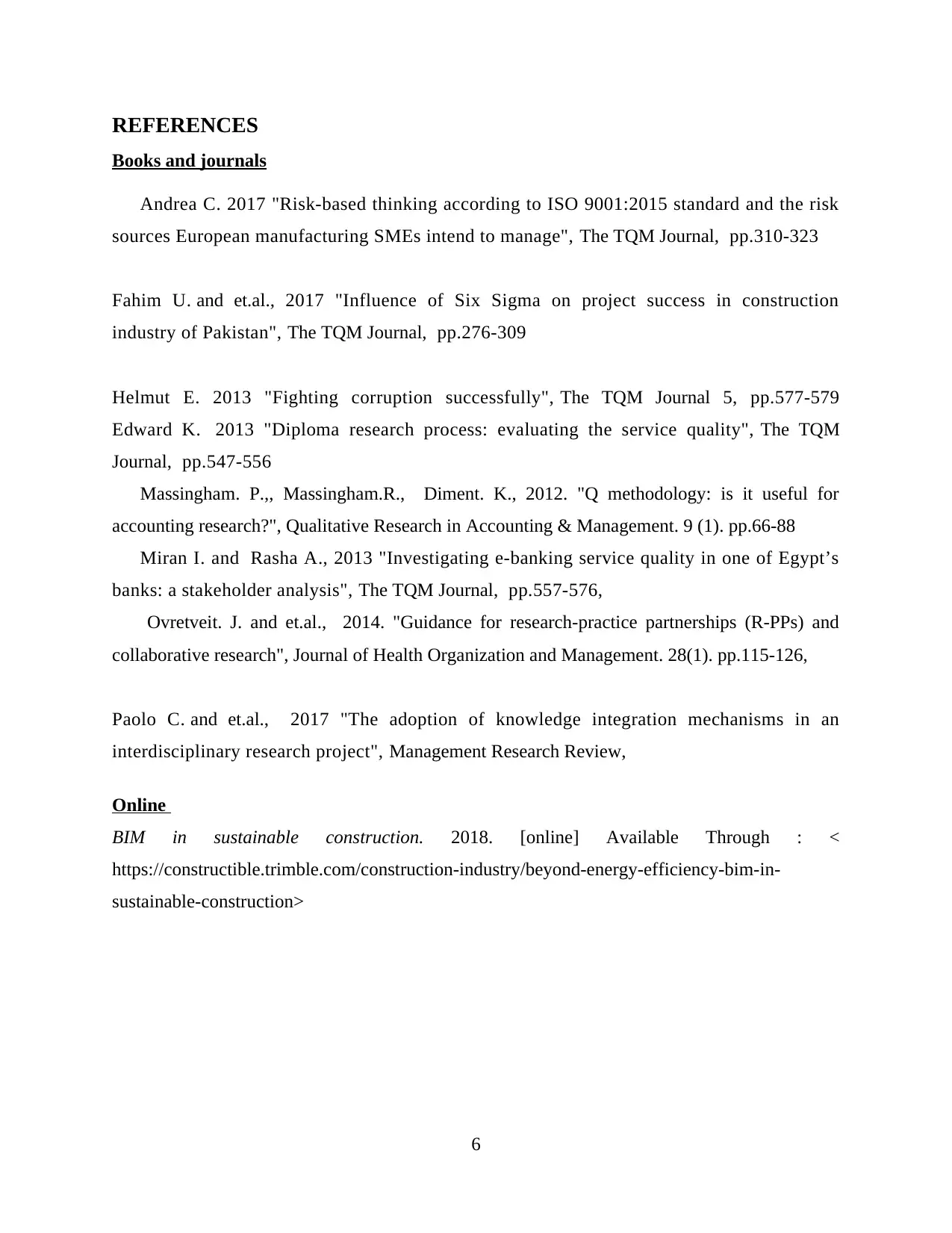
REFERENCES
Books and journals
Andrea C. 2017 "Risk-based thinking according to ISO 9001:2015 standard and the risk
sources European manufacturing SMEs intend to manage", The TQM Journal, pp.310-323
Fahim U. and et.al., 2017 "Influence of Six Sigma on project success in construction
industry of Pakistan", The TQM Journal, pp.276-309
Helmut E. 2013 "Fighting corruption successfully", The TQM Journal 5, pp.577-579
Edward K. 2013 "Diploma research process: evaluating the service quality", The TQM
Journal, pp.547-556
Massingham. P.,, Massingham.R., Diment. K., 2012. "Q methodology: is it useful for
accounting research?", Qualitative Research in Accounting & Management. 9 (1). pp.66-88
Miran I. and Rasha A., 2013 "Investigating e-banking service quality in one of Egypt’s
banks: a stakeholder analysis", The TQM Journal, pp.557-576,
Ovretveit. J. and et.al., 2014. "Guidance for research-practice partnerships (R-PPs) and
collaborative research", Journal of Health Organization and Management. 28(1). pp.115-126,
Paolo C. and et.al., 2017 "The adoption of knowledge integration mechanisms in an
interdisciplinary research project", Management Research Review,
Online
BIM in sustainable construction. 2018. [online] Available Through : <
https://constructible.trimble.com/construction-industry/beyond-energy-efficiency-bim-in-
sustainable-construction>
6
Books and journals
Andrea C. 2017 "Risk-based thinking according to ISO 9001:2015 standard and the risk
sources European manufacturing SMEs intend to manage", The TQM Journal, pp.310-323
Fahim U. and et.al., 2017 "Influence of Six Sigma on project success in construction
industry of Pakistan", The TQM Journal, pp.276-309
Helmut E. 2013 "Fighting corruption successfully", The TQM Journal 5, pp.577-579
Edward K. 2013 "Diploma research process: evaluating the service quality", The TQM
Journal, pp.547-556
Massingham. P.,, Massingham.R., Diment. K., 2012. "Q methodology: is it useful for
accounting research?", Qualitative Research in Accounting & Management. 9 (1). pp.66-88
Miran I. and Rasha A., 2013 "Investigating e-banking service quality in one of Egypt’s
banks: a stakeholder analysis", The TQM Journal, pp.557-576,
Ovretveit. J. and et.al., 2014. "Guidance for research-practice partnerships (R-PPs) and
collaborative research", Journal of Health Organization and Management. 28(1). pp.115-126,
Paolo C. and et.al., 2017 "The adoption of knowledge integration mechanisms in an
interdisciplinary research project", Management Research Review,
Online
BIM in sustainable construction. 2018. [online] Available Through : <
https://constructible.trimble.com/construction-industry/beyond-energy-efficiency-bim-in-
sustainable-construction>
6
⊘ This is a preview!⊘
Do you want full access?
Subscribe today to unlock all pages.

Trusted by 1+ million students worldwide

7
1 out of 10
Related Documents
Your All-in-One AI-Powered Toolkit for Academic Success.
+13062052269
info@desklib.com
Available 24*7 on WhatsApp / Email
![[object Object]](/_next/static/media/star-bottom.7253800d.svg)
Unlock your academic potential
Copyright © 2020–2025 A2Z Services. All Rights Reserved. Developed and managed by ZUCOL.





